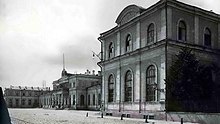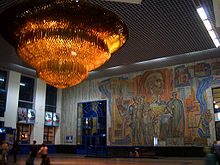Moscow Railway Station (Nizhny Novgorod)
| Nizhny Novgorod railway station | |
|---|---|
|
General view of the train station from Revolution Square
|
|
| Data | |
| Location in the network | Crossing station |
| Design | Tower station |
| Platform tracks | 6 (Fernbahn) 2 (S-Bahn) 2 (U-Bahn, below) |
| Price range | 1 |
| opening | August 2, 1862 |
| location | |
| City / municipality | Nizhny Novgorod |
| Place / district | Kanawinski rajon |
| Oblast | Nizhny Novgorod |
| Country | Russia |
| Coordinates | 56 ° 19 '19 " N , 43 ° 56' 45" O |
| Railway lines | |
| List of train stations in Russia | |
The Nizhny Novgorod station (also Moscow station , Russian Московский вокзал Moskowski Voksal ) is the main station of the Russian metropolis of Nizhny Novgorod . Nizhny Novgorod-Moskovsky passenger station (in Russian: Нижний Новгород-Московский , until March 30, 2010 Gorky-Moskovsky, in Russian Горький-Московский ). It belongs to the Gorkier Railway , a regional division of the Russian State Railways .
Geographical location and connection
The station is located on the Trans-Siberian Railway and in Nizhny Novgorod on Ploshchad Revolyutsii ( Russian Площадь Революции , Revolution Square) on the west side of the Oka -Flusses. The S-Bahn , tram 1 and some Marschrutka lines connect it with the city center . The nearby Moskovskaya metro station ( Московская ) forms the transition point between the two existing metro lines . There is a stop for long-distance buses to Moscow, Kostroma and Kirov around the corner on Sovetskaya Street ( Улица Советская ).
history
The Nizhny Novgorod Railway Station was built in 1862 when the Moscow - Vladimir Railway was being extended. On August 2, 1862, traffic on the Vladimir - Nizhny Novgorod section was opened. The station became the terminus of the Moscow-Nizhny-Novgorod railway . It consisted of three two-story buildings, which were connected by passages to the lobby in the center, waiting rooms, post office, telegraphy, buffets and restaurants. A clock was installed on the central tower. The walls of the building were decorated with mosaic panels on heroic themes.
In 1894 the imperial pavilion was built for the arrival of the emperors in the city. The architect Dmitry Chichagov, representative of the famous Russian architectural dynasty, designed both the building and the interior. The hall of the pavilion was decorated with a large portrait of Nicholas II . And adorned a carved fireplace in white Italian marble. A telephone was installed for important calls. The pavilion received the emperor twice: in 1896 during the All-Russian Exhibition and in 1913 during the celebrations of the 300th anniversary of the Romanov dynasty . It was captured by rebels during the 1905 Revolution and held for some time. After the October Revolution of 1917, the Kanavino Bolshevik Committees and the railway medical facility were in the building at different times.
The Soviet government kept the old building for a long time. During the Second World War , the Moscow Railway Station, along with the Kazan Railway Station, became an important strategic object. To connect the two stations, railroad tracks were laid through the Freight Port Headland and Kanawinski Bridge. The air force tried several times to bomb the station, but was unsuccessful. Bombs fell on Revolution Square and near the modern building of the central department store. After winning the war , the trainloads arrived at the station with victorious soldiers.
In the 1960s, the station building was completely rebuilt to get a so-called "civilian" look. The entire historical facade was destroyed. There were also major changes inside the station: the "pre-revolutionary" mosaics were replaced by Soviet ones in the spirit of the 20th century, the waiting rooms and many other rooms were rebuilt. In the middle of the hall was a huge chandelier made of various metal plates, made in the Netherlands . It has become a symbol of the renewed Soviet station and a meeting place for millions of passengers.
In 1985, after the start of the metro , the exits to the long tunnel to the Moskovskaya subway station in the terminal building were equipped.

Since 2002 the station has been modernized and equipped with terminals for the automatic checking of tickets and the construction of sheds above the platforms. From June 2017, the station was closed for renovation work and only opened on April 28, 2018.
At the time of the reconstruction, the departure of passengers to platforms for long-distance trains and to electric trains took place through suburban tunnels. After the rebuilding, an updated terminal appeared that was set up and remodeled in the spirit of the 21st century. In the waiting rooms there are cameras and shelves for charging mobile devices with combination locks. The huge chandelier was dismantled and sent to the warehouse. Only two mosaic panels on the side walls inside the building have survived from the Soviet era.
March 30, 2010 The Gorky-Moskovsky station was renamed to its current name Nizhny-Novgorod-Moskovsky. On July 1 of the same year, the name of the Gorky-Moskovsky station was changed to Nizhny Novgorod by order of the President of the Russian Railway Company JSC Vladimir Yakunin . However, the name on the station itself was not changed from Moscow station to main station until April 2014, as it was only funded at that time.
business
Several night trains run daily from the through station to Moscow to the Kursk , Kazan and Yaroslavl stations . There are also direct connections to Adler , Ufa (via Samara ), Vladivostok , Yekaterinburg , Vorkuta , Astrakhan , Simferopol and St. Petersburg (as of October 2007).
literature
- NN: Reconstruction of Nizhny Novgorod railway station tob e completed in 2018 - in time for the Football World Championship in Russia . In: OSJD Bulletin 3/2017, p. 47.
Individual evidence
- ↑ Arrangement no. 196 ( page no longer available , search in web archives ) Info: The link was automatically marked as defective. Please check the link according to the instructions and then remove this notice. of the Government of the Russian Federation of March 30, 2010 on the renaming of various train stations (Russian)
- ^ NN: Reconstruction .
- ↑ Московский вокзал / Централизованная библиотечная система Канавинского района. Retrieved January 22, 2019 (Russian).
- ↑ Императорский павильон Московского вокзала и сохранение культурного наследия на Горьковскозн Горьковскозн желедей. Retrieved January 22, 2019 (Russian).
- ↑ Горький (Нижний Новгород). История ... Retrieved January 22, 2019 .
- ↑ Реконструкция вокзального комплекса Нижний Новгород. Retrieved January 22, 2019 (Russian).
- ↑ Путин подписал распоряжение о переименовании станции "Горький - Московский" | ИА «НТА Приволжье» Новости Нижнего Новгорода. Retrieved January 22, 2019 (Russian).
- ↑ Приказ ОАО РЖД от July 1, 2010 N 97. Accessed January 22, 2019 (Russian).
- ↑ "Московский вокзал" в Нижнем Новгороде стал "Железнодорожным" | ИА «НТА Приволжье» Новости Нижнего Новгорода. Retrieved January 22, 2019 (Russian).




